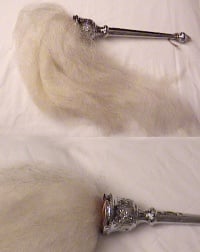Chaur sahib
Chaur Sahib is an implement normally found next to the Mannji Sahib where the Sri Guru Granth Sahib is placed during the day within the Gurdwara's Darbar Sahib (Main Hall). It is these days constructed from yak hair and has a wooden or metal handle. The Sevadar (volunteer) respectfully waves the Chaur Sahib above the Guru Sahib as a sign of respect and dedication. It is regarded as seva (service) of very high calibre for the Guru and most Sikhs at some point would undertake to do this Seva at their local Gurdwara or at their home if they have the Sri Guru Granth Sahib. This seva shows reverence for the message carried by the Guru (Gurbani) and humility (Nimrata) for the word of the Guru. Further, when the Sevadar waves the Chaur Sahib, he or she would silently recite the Gurmantar, Waheguru. So one, not only performs seva but also undertakes Simran at the same time as well. Both these together form the foundation of Sikhism – see Sikh Beliefs
During the time of the first ten Gurus, this tradition was born for various reasons. It was common practise in Punjab for the younger members of family to perform seva for their elders by waving fans in hot condition to create movement of air and cool the person and also to keep flies away from the person. During this earlier period, the chaur was made of wood and canvas and created a good airflow when waved. This tradition was also used with the Gurus and is now used with the Sri Guru Granth Sahib. It was also a tradition used for kings and royalty.
These days, with the advent of air conditioning and electric fans, the movement of air is not so important but the "seva" element has taken on a more important and overriding role. The Sikhs treat the Sri Guru Granth Sahib as a "living Guru" and so all the traditions that would be accorded to a "human Guru" are accorded to the SGGS as far as practically possible. The Chaur Seva is just one of those central traditions that the Sikhs practise to honour their Guru with the high regard and respect that Gurbani deserves. The Sikhs do not worship the SGGS for this is forbidden – Only the One Almighty God is to be worshipped, for He is the Creator of everything that can be perceived and also those things that cannot be perceived.
During the time of the first ten Gurus, the congregation (Sangat) and Sevadar (volunteers) who came from afar to see the Gurus wanted to be close to the Gurus and listen to their advice and guidance (Shabad). So they would sit near Guru ji and listen to the words of wisdom from the Guru and do Chaur Seva for the Guru. This seva was done turn by turn by many members of the congregation (Sangat) to be as close to the Guru as possible and also to get involved in Seva which with Simran forms the foundation of Sikhism – see Sikh Beliefs

